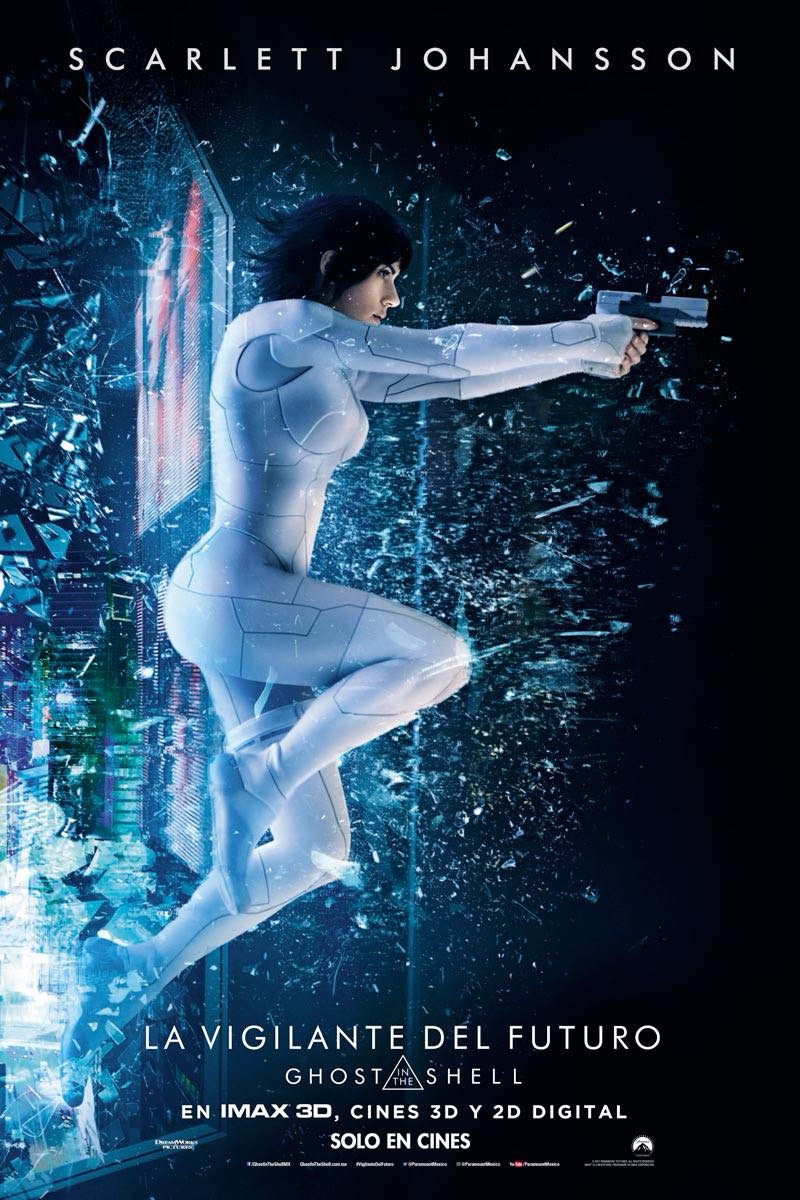Ghost in the Shell (2017)

The 2017 live-action adaptation of Ghost in the Shell, directed by Rupert Sanders, was a highly anticipated yet controversial project. Based on the iconic 1995 anime film and Masamune Shirow’s original manga, this version of Ghost in the Shell aimed to bring the cyberpunk world to a wider, global audience. Starring Scarlett Johansson as Major Mira Killian (the live-action counterpart of Major Motoko Kusanagi), the film delivers a visually dazzling spectacle, but it struggles to fully capture the depth, philosophy, and complexity of the original material.
Suggested videos for you:
Plot Overview
Set in a futuristic, cyberpunk world where humans can augment their bodies with cybernetic enhancements, the story follows Major Mira Killian, a woman whose brain has been placed in a completely synthetic body (known as a “shell”) after a terrible accident. She becomes the ultimate weapon in fighting cyberterrorism, working for an elite task force called Section 9, which is led by Chief Daisuke Aramaki (Takeshi Kitano). As the Major investigates a mysterious hacker known as Kuze (Michael Pitt), who has been targeting high-ranking employees of the Hanka Robotics corporation, she begins to uncover disturbing truths about her past and the true nature of her creation.
The central plot revolves around Major’s quest for identity, as she grapples with her fragmented memories and the realization that she may not have been a willing participant in the procedure that made her into a cyborg. As she gets closer to the hacker Kuze, she learns that her life story may have been fabricated and that her real identity has been hidden by the corporation that now controls her. Ultimately, she must decide whether to trust her creators or reclaim her true self.
Themes
One of the central themes of Ghost in the Shell is the concept of identity and the blurred line between human and machine. The original anime and manga are known for their deep philosophical explorations of what it means to be human in an age where technology can alter the body and mind. In the 2017 film, the Major’s search for her true identity is framed as a personal journey of self-discovery, but the film fails to delve as deeply into the broader existential questions raised by the original material.
The question of identity in a post-human world, where memories can be manipulated and bodies replaced, is still present, but the 2017 film simplifies the complexity of these ideas, focusing more on the Major’s quest for personal liberation than on the broader societal implications. The themes of corporate control and the dangers of unchecked technological advancement are also explored, with Hanka Robotics functioning as the film’s antagonist, representing the faceless power of corporations that treat human life as a commodity.
However, what the film lacks is the nuanced, philosophical inquiry that defined the original anime. The anime’s contemplation of the “ghost” (the soul or consciousness) within the “shell” (the cybernetic body) is reduced to a more conventional narrative of corporate conspiracy and personal revenge. As a result, the film loses some of the intellectual heft that made Ghost in the Shell a cyberpunk classic.
Visuals and World-Building
Where the 2017 Ghost in the Shell excels is in its visuals and production design. The film’s depiction of a futuristic, cyberpunk cityscape is stunning, with towering skyscrapers, neon-lit streets, and holographic advertisements that evoke comparisons to Ridley Scott’s Blade Runner. The city, unnamed in the film, is a blend of Eastern and Western influences, mirroring the aesthetic of the original anime but with even more emphasis on the fusion of cultures, technology, and artificiality. The design of the city and its environments is immersive, capturing the sense of a world that has fully embraced the merger of man and machine.
The cybernetic enhancements and the technology on display are visually impressive, from the Major’s thermoptic camouflage (a transparent suit that allows her to become invisible) to the intricate designs of the cyborg bodies. The attention to detail in the futuristic technology is one of the film’s highlights, showing a world where the boundaries between human and machine have blurred almost beyond recognition.
The action sequences, particularly those that mirror iconic scenes from the original anime, are well-executed. One of the most notable is the recreation of the Major’s battle with a cloaked enemy in a shallow pool of water, which remains one of the film’s most visually memorable moments. The climactic battle with the spider-tank is also an impressive blend of CGI and practical effects, providing a satisfying visual spectacle.
However, while the film excels in aesthetics, it is often criticized for prioritizing style over substance. The visual homage to the original anime is clear, but the philosophical depth that underpinned those visuals is largely absent.
Performances
Scarlett Johansson’s casting as Major Mira Killian was one of the most controversial aspects of the film, sparking widespread criticism of whitewashing. The Major, a Japanese character in the original anime, was played by a white actress in this adaptation, which many saw as a missed opportunity to cast a Japanese or Asian actress in a major Hollywood role. Johansson’s performance itself is solid—she captures the Major’s stoicism and physicality, embodying a character who is more machine than human. However, the film’s treatment of the Major’s identity fails to address or acknowledge the cultural implications of the character’s race, which further fueled the controversy surrounding the film’s release.
In terms of her portrayal, Johansson delivers a measured, restrained performance, conveying the Major’s internal conflict and growing unease as she unravels the truth about her past. However, the emotional depth of the character’s journey is somewhat diluted by the film’s focus on action and spectacle over introspection. There is a sense that Johansson’s Major is more defined by her physical prowess and outward appearance than by her inner struggles with her identity as both human and machine.
Michael Pitt, as Kuze, delivers a haunting performance as the primary antagonist, though his character is a significant departure from the Puppet Master of the original anime. Kuze is portrayed as a tragic figure, a victim of the same experiments that created the Major, and his connection to her adds an emotional layer to the conflict. While Pitt’s performance is effective, his character is underdeveloped, and the film misses the opportunity to explore the philosophical implications of his rebellion against the system that created him.
Takeshi Kitano, as Chief Aramaki, provides gravitas to the film, speaking entirely in Japanese and serving as a counterbalance to the film’s more action-oriented elements. However, his character is underutilized, and his interactions with the Major are minimal compared to the rich mentor-protégé dynamic seen in other adaptations of Ghost in the Shell.
Direction and Writing
Rupert Sanders’ direction emphasizes the visual spectacle of the world he is creating, but the film struggles to find a balance between action and introspection. Sanders is clearly invested in paying homage to the original material, often replicating iconic scenes shot-for-shot, but the deeper philosophical questions that made Ghost in the Shell a cyberpunk masterpiece are largely glossed over. The script, penned by Jamie Moss, William Wheeler, and Ehren Kruger, is more concerned with delivering a streamlined, accessible narrative than in exploring the complex themes of identity, technology, and consciousness that defined the source material.
While the film attempts to tackle the Major’s struggle with her identity, it simplifies the storyline into a more conventional revenge arc. The nuanced debate about what it means to be human is sidelined in favor of a more straightforward plot about a woman uncovering the truth about her past, which detracts from the thematic richness of the original.
Reception and Legacy
The 2017 Ghost in the Shell was met with mixed reviews upon its release. While it was praised for its visuals, world-building, and action sequences, it was widely criticized for its lack of depth and its failure to engage with the philosophical questions that made the original anime so influential. The whitewashing controversy also overshadowed the film’s release, leading to significant backlash and discussions about Hollywood’s casting practices.
For fans of the original, the live-action Ghost in the Shell often feels like a missed opportunity. It is a visually impressive film that faithfully recreates many of the iconic moments from the anime, but it lacks the intellectual rigor and emotional depth that made those moments so powerful in the first place. While it serves as an introduction to the world of Ghost in the Shell for new audiences, it ultimately falls short of living up to the legacy of its predecessors.
Conclusion
Ghost in the Shell (2017) is a visually stunning yet narratively shallow adaptation of a beloved cyberpunk classic. Despite Scarlett Johansson’s strong performance and the film’s impressive production design, it fails to capture the complexity and philosophical depth of the original anime and manga. While it offers plenty of action and spectacle, it lacks the substance that made Ghost in the Shell a groundbreaking exploration of identity, technology, and humanity. Ultimately, it’s a film that is more style than substance, offering a visually rich but thematically hollow experience.











